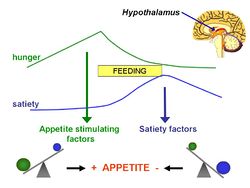Obesogenic environment
For the course duration, the article is closed to outside editing. Of course you can always leave comments on the discussion page. The anticipated date of course completion is 01 April 2012. One month after that date at the latest, this notice shall be removed. Besides, many other Citizendium articles welcome your collaboration! |
The obesogenic environment encompasses the environmental features of modern lifestyles that are postulated to contribute to the increasing prevalence of obesity; in particular, it is thought that the wide availability of food that is energy dense, palatable and inexpensive, combined with increasingly sedentary habits, favour an excess of energy intake over expenditure.[1] Helen Martin 11:38, 22 October 2011 (UTC)
The obesogenic environment.
Over the past 40 years the prevalence of obesity has become a cause for concern, the dramatic rise in rates of obesity amongst both adults and children, 1.46 billions adults and 70 million children are estimated to be overweight or obese in 2008[2], so what is it that is making us fat?
In the Lancet 2011 series on obesity[2], there were a number of suggestions as to why obesity rates have risen, and continue to rise, so rapidly. Perhaps it is our environment that is to blame, and that obesity represents ‘a normal reaction to an abnormal environment.[2]
Modern lifestyles.
Chronic stress and obesity.
People reporting feeling stressed has doubled since the 1990’sCite error: Invalid <ref> tag; invalid names, e.g. too many, even though the hours spent at work in the UK is average amongst other European countries,(3) the amount of unpaid work, mainly caring for children and housework done predominately by women is above average compared to other countries within the EU(3). This survey only took into account the working population, suggesting that even though, the amount of time spent at work hasn’t increased, juggling family commitments and employment may lead to increased rates of stress related ill health.
So, is it our fault we are getting fat? The relationship between stress and obesity; being chronically stressed increases the amount of comfort food ingested by rats(4). Chronic stress as opposed to acute stress, results in increased concentration of glucocorticoids, cortisol in humans and corticosterone in rodents, over a prolonged period of time(5). High levels of glucocorticoid over a long period, rather than negatively feeding back on the HPA axis reducing the amount of glucocorticoids produced, become excitatory(5). This is important and accounts for the differences in the reaction between acute and chronic stress responses. Eating ‘comfort food’, defined as food high in carbohydrate and sugar,(4) is proposed to dampen down the HPA axis decreasing anxiety levels associated with the excitatory effect of prolonged high glucocorticoid levels. Increased cortisol levels correlate with obesity, as seen in Cushing’s disease where a pathological overproduction of cortisol because of abnormal stimulation of the HPA axis leads to abdominal obesity. This increase in cortisol is also seen in stress and depressed individuals as compared to a control group.(6) But which comes first, the increase in cortisol or the obesity? Adipose tissue contains the enzyme 11-beta hydroxysteroid type one which converts inactive cortisone to cortisol, the more adipose tissue you have the more conversion(6), thus breaking this cycle may be important in tackling obesity. There is also significant evidence that high stress levels, leading to high cortisol levels, during pregnancy can lead to a predisposition for the offspring to be of a low birth weight who then go on to develop many of the adverse effects associated with obesity, predominantly the metabolic syndrome later in life.(7) The placenta is the barrier between mother and fetus, preventing the fetus from being overly exposed to high cortisol levels, this protection comes in the form of the enzyme 11 beta hydroxysteroid dehydrogenase 2 which, in humans, converts active cortisol to inactive cortisone. Mothers who are exposed to high stress levels or are given exogenous steroids override this enzyme barrier resulting in increased exposure of the fetus to glucocorticoids.These offspring have over expression of glucocorticoid receptors in adipose tissue and an impaired response to stress.(7)
Being obese in pregnancy also has a negative effect on the health of the offspring, the prevalence of obesity in pregnancy is increasing,(8) the timing may be critical for the impact on the offspring, whether there is over nutrition during pregnancy or during both pregnancy and lactation.(8) It is suggested that maternal over nutrition directly affects fetal brain development causing altered appetite, adipocyte differentiation and reduced energy expenditure.(8) Converse to the low birth weight, and subsequent ‘catch up growth,’ in children exposed to high glucocorticoid levels, in maternal obesity results in increased birth weight and a predisposition to being obese in childhood.(8) Studies has also show that maternal diet in pregnancy, particularly one which is high in protein and low in carbohydrates, results in an overactive HPA axis and increased cortisol release in response to stress.(9) Interestingly it seems that the negative effects of ‘fetal programming’ is not constrained to the offspring but can also effect the next generation as well, research is currently being undertaken to see whether the next generation (the great grandchildren of the mother who received the original insult) are affected.
References
- ↑ Chaput JP et al. (2011) Modern sedentary activities promote overconsumption of food in our current obesogenic environment Obes Rev 12:e12-20 PMID 20576006
- ↑ 2.0 2.1 2.2 Rutter H (2011) Where next for obesity? Lancet
